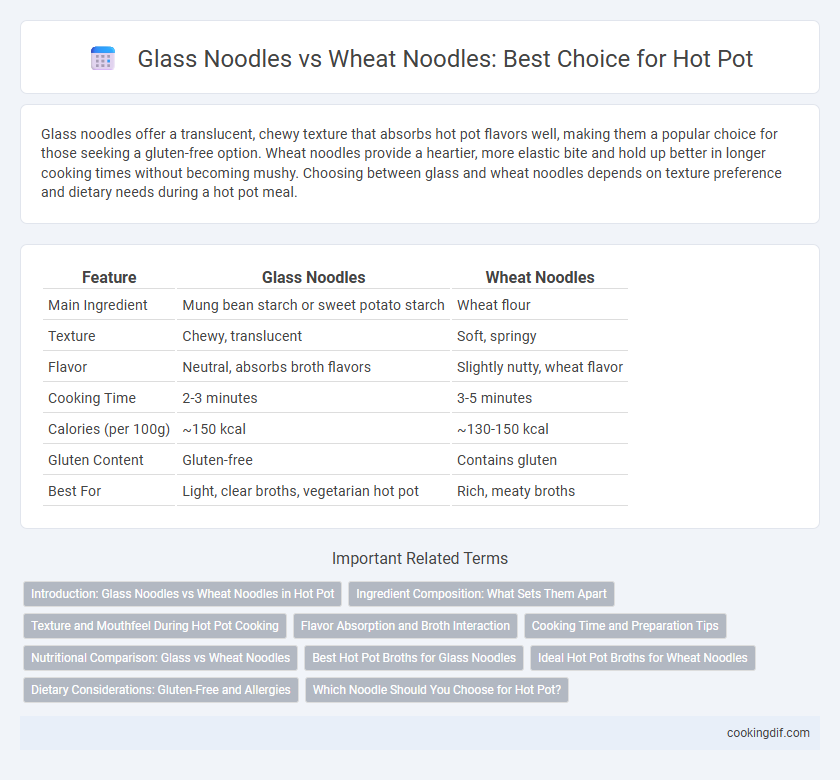Glass noodles offer a translucent, chewy texture that absorbs hot pot flavors well, making them a popular choice for those seeking a gluten-free option. Wheat noodles provide a heartier, more elastic bite and hold up better in longer cooking times without becoming mushy. Choosing between glass and wheat noodles depends on texture preference and dietary needs during a hot pot meal.
Table of Comparison
| Feature | Glass Noodles | Wheat Noodles |
|---|---|---|
| Main Ingredient | Mung bean starch or sweet potato starch | Wheat flour |
| Texture | Chewy, translucent | Soft, springy |
| Flavor | Neutral, absorbs broth flavors | Slightly nutty, wheat flavor |
| Cooking Time | 2-3 minutes | 3-5 minutes |
| Calories (per 100g) | ~150 kcal | ~130-150 kcal |
| Gluten Content | Gluten-free | Contains gluten |
| Best For | Light, clear broths, vegetarian hot pot | Rich, meaty broths |
Introduction: Glass Noodles vs Wheat Noodles in Hot Pot
Glass noodles, made from mung bean starch or sweet potato starch, offer a transparent, chewy texture that absorbs hot pot broth flavors well, enhancing the dish's umami profile. Wheat noodles, typically made from wheat flour and gluten, provide a firmer, more substantial bite, contributing a hearty texture that complements rich and spicy broths commonly used in hot pot. Choosing between glass noodles and wheat noodles depends on desired texture and flavor absorption, with glass noodles favored for their lightness and wheat noodles prized for their robust mouthfeel.
Ingredient Composition: What Sets Them Apart
Glass noodles, made primarily from mung bean starch or sweet potato starch, offer a translucent appearance and a chewy texture perfect for hot pot. Wheat noodles are composed of wheat flour and gluten, providing a denser and more elastic bite that holds up well in broth. The starch-based composition of glass noodles results in a gluten-free option, distinguishing them from wheat noodles, which contain gluten and have a heartier nutritional profile.
Texture and Mouthfeel During Hot Pot Cooking
Glass noodles offer a smooth, slippery texture that maintains a pleasant chewiness without becoming mushy in hot pot broth, enhancing the overall mouthfeel. Wheat noodles provide a firmer, more elastic bite that holds up well to prolonged cooking, delivering a satisfying, springy texture. Choosing between them depends on preferred noodle resilience and how they absorb the soup's flavors during cooking.
Flavor Absorption and Broth Interaction
Glass noodles excel in flavor absorption due to their translucent, gelatinous texture that soaks up broth flavors more effectively than wheat noodles. Wheat noodles tend to maintain a firmer bite, offering a more neutral taste that complements but does not overpower the hot pot broth. The broth interaction with glass noodles creates a richer, more infused dining experience, while wheat noodles provide balance and texture contrast.
Cooking Time and Preparation Tips
Glass noodles, made from mung bean starch, cook quickly in hot pot, typically within 2-3 minutes, making them ideal for fast meals. Wheat noodles require longer cooking times, usually around 5-7 minutes, and benefit from pre-soaking to ensure even texture and prevent clumping. For best results, add glass noodles near the end of cooking, while wheat noodles can be added earlier to fully absorb the hot pot broth flavors.
Nutritional Comparison: Glass vs Wheat Noodles
Glass noodles, made from mung bean starch, offer a gluten-free option rich in complex carbohydrates and low in fat, making them a suitable choice for those with gluten sensitivity or seeking lower-calorie alternatives in hot pot dishes. Wheat noodles contain higher protein content and a broader range of B vitamins, contributing to energy metabolism and muscle repair, but also include gluten, which may affect digestion for some individuals. Comparing glycemic indices, glass noodles generally have a lower impact on blood sugar levels, positioning them as a favorable choice for blood sugar management during hot pot meals.
Best Hot Pot Broths for Glass Noodles
Glass noodles, made from mung bean starch, absorb flavors from hot pot broths like spicy Sichuan or savory miso exceptionally well, enhancing their natural chewy texture. These clear, slippery noodles complement broths rich in umami, such as beef bone or kimchi-based broths, providing a refreshing contrast to denser ingredients. Their ability to soak up intense, aromatic flavors without overpowering the broth makes them ideal for hot pot dishes seeking a balance of taste and texture.
Ideal Hot Pot Broths for Wheat Noodles
Wheat noodles pair best with rich, savory hot pot broths such as beef bone broth or spicy Sichuan-style soup, as their chewy texture absorbs and enhances bold flavors. Unlike glass noodles, wheat noodles maintain their firmness longer in hearty broths, making them ideal for slow-cooked hot pot recipes. Their gluten content allows them to hold shape and flavor, complementing broths with umami depth and robust spices.
Dietary Considerations: Gluten-Free and Allergies
Glass noodles, made from mung bean or sweet potato starch, offer a gluten-free option ideal for those with celiac disease or gluten sensitivity, making them a safe choice for hot pot diners with dietary restrictions. Wheat noodles contain gluten, which can trigger allergic reactions or digestive issues in individuals with wheat allergies or gluten intolerance. Choosing glass noodles over wheat noodles ensures a more inclusive hot pot experience, accommodating diverse dietary needs without compromising texture or flavor.
Which Noodle Should You Choose for Hot Pot?
Glass noodles, made from mung bean starch, offer a translucent appearance and a chewy texture that absorbs hot pot broth flavors well, making them ideal for light or spicy broths. Wheat noodles, rich in gluten, provide a firmer bite and a heartier taste that holds up better in thicker, meat-based hot pots. Choosing between glass and wheat noodles depends on your preferred broth type and desired noodle texture for an optimal hot pot experience.
Glass Noodles vs Wheat Noodles for hot pot Infographic

 cookingdif.com
cookingdif.com